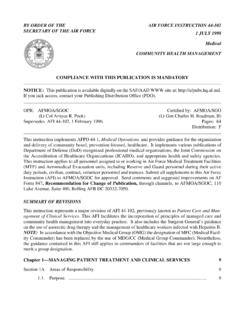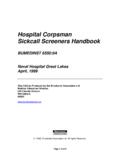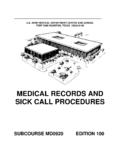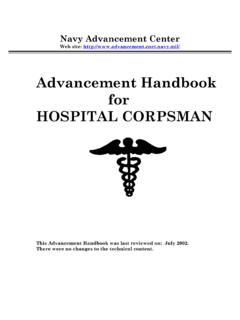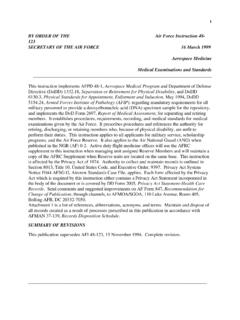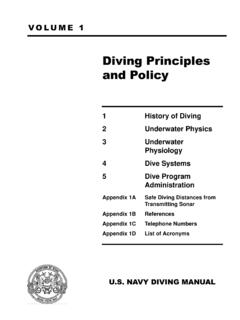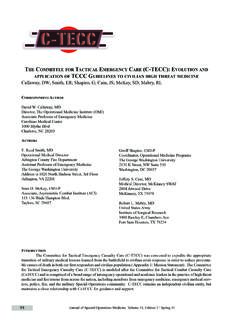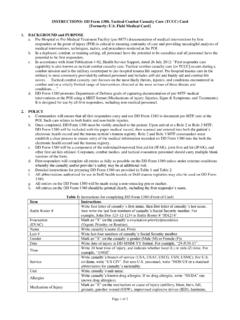Transcription of TACTICAL COMBAT CASUALTY CARE AND ... - Operational …
1 ARMY MEDICAL DEPARTMENT CENTER AND SCHOOL FORT SAM HOUSTON, TEXAS 78234-6100 TACTICAL COMBAT CASUALTY care AND WOUND TREATMENT SUBCOURSE MD0554 EDITION 200 DEVELOPMENT This subcourse is approved for resident and correspondence course instruction. It reflects the current thought of the Academy of Health Sciences and conforms to printed Department of the Army doctrine as closely as currently possible. Development and progress render such doctrine continuously subject to change.
2 ADMINISTRATION Students who desire credit hours for this correspondence subcourse must enroll in the subcourse. Application for enrollment should be made at the Internet website: You can access the course catalog in the upper right corner. Enter School Code 555 for medical correspondence courses. Copy down the course number and title. To apply for enrollment, return to the main ATRRS screen and scroll down the right side for ATRRS Channels. Click on SELF DEVELOPMENT to open the application; then follow the on-screen instructions.
3 For comments or questions regarding enrollment, student records, or examination shipments, contact the Nonresident Instruction Branch at DSN 471-5877, commercial (210) 221-5877, toll-free 1-800-344-2380; fax: 210-221-4012 or DSN 471-4012, e-mail or write to: NONRESIDENT INSTRUCTION BRANCH AMEDDC&S ATTN: MCCS-HSN 2105 11TH STREET SUITE 4191 FORT SAM HOUSTON TX 78234-5064 Be sure your social security number is on all correspondence sent to the Academy of Health Sciences.
4 CLARIFICATION OF TERMINOLOGY When used in this publication, words such as "he," "him," "his," and "men" 'are intended to include both the masculine and feminine genders, unless specifically stated otherwise or when obvious in context. USE OF PROPRIETARY NAMES The initial letters of the names of some products may be capitalized in this subcourse. Such names are proprietary names, that is, brand names or trademarks. Proprietary names have been used in this subcourse only to make it a more effective learning aid.
5 The use of any name, proprietary or otherwise, should not be interpreted as endorsement, deprecation, or criticism of a product; nor should such use be considered to interpret the validity of proprietary rights in a name, whether it is registered or not. MD0554 i TABLE OF CONTENTS Lesson Paragraphs INTRODUCTION 1 TACTICAL COMBAT CASUALTY care 1-1 -- 1-5 Exercises 2 CONTROLLING BLEEDING FROM AN EXTREMITY Section I.
6 General 2-1 -- 2-5 Section II. Controlling External Bleeding From a Wound on an Extremity 2-6 -- 2-21 Section III. Applying an Improvised Tourniquet 2-22 -- 2-27 Section IV. Controlling Bleeding From an Amputation 2-28 -- 2-31 Section V. Treating Internal Bleeding in an Extremity 2-32 -- 2-35 Exercises 3 TREATING CHEST INJURIES. Section I. General 3-1 -- 3-3 Section II. Treating Open Chest Wounds 3-4 -- 3-13 Section III.
7 Treating Closed Chest Injuries 3-14 -- 3-25 Exercises 4 TREATING ABDOMINAL INJURIES Section I. General 4-1 -- 4-2 Section II. Treating Open Abdominal Wounds 4-3 -- 4-11 Section III. Treating an Acute Abdomen 4-12-- 4-14 Exercises 5 TREATING HEAD INJURIES Section I. Open and Closed Head Injuries 5-1 -- 5-4 Section II. Treating Open Head Wounds 5-5 -- 5-10 Section III. Treating Other Injuries 5-11-- 5-15 Exercises MD0554 ii Lesson Paragraphs 6 TREATING BURNS Section I.
8 General 6-1 -- 6-3 Section II. Treating Thermal Burns 6-4 -- 6-13 Section III. Treating Electrical Burns 6-14-- 6-20 Section IV. Treating Chemical Burns 6-21-- 6-25 Section V. Treating Radiant Energy Burns 6-26-- 6-28 Exercises 7 TREATING HYPOVOLEMIC SHOCK 7-1 -- 7-8 Exercises 8 TREATING SOFT TISSUE INJURIES 8-1 -- 8-6 Exercises MD0554 iii CORRESPONDENCE COURSE OF THE ARMY MEDICAL DEPARTMENT CENTER AND SCHOOL SUBCOURSE MD0554 TACTICAL COMBAT CASUALTY care AND WOUND TREATMENT INTRODUCTION When you have
9 Casualties on the battlefield, you must determine the sequence in which the casualties are to be treated and how to treat their injuries. This subcourse discusses the procedures for performing TACTICAL COMBAT CASUALTY care ; treating injuries to the extremities, chest, abdominal, and head; and controlling shock. Subcourse Components: This subcourse consists of eight lessons. The lessons are: Lesson 1, TACTICAL COMBAT CASUALTY care . Lesson 2, Controlling Bleeding From an Extremity. Lesson 3, Treating Chest Injuries.
10 Lesson 4, Treating Abdominal Injuries. Lesson 5, Treating Head Injuries. Lesson 6, Treating Burns. Lesson 7, Treating Hypovolemic Shock. Lesson 8, Treating Soft Tissue Injuries. Here are some suggestions that may be helpful to you in completing this subcourse: --Read and study each lesson carefully. --Complete the subcourse lesson by lesson. After completing each lesson, work the exercises at the end of the lesson, marking your answers in this booklet.
